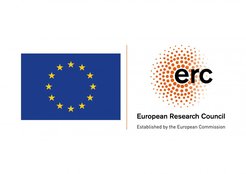
M2FINDERS – Mapping Magnetic Fields with INterferometry Down to Event hoRizon Scales
ERC Advanced Grant (2021-26)
Principal Investigator: Prof. J. Anton Zensus - Project No. 101018682
Active galactic nuclei (AGN) are the most extreme sources of radiative and kinetic power in the Universe. Rotating supermassive black holes (SMBH), accretion disks, relativistic plasma jets, and magnetic fields are key in producing the required energies and transporting these outwards. An important step in understanding the innermost regions in these extreme objects was the image of the silhouette of the black hole in the galaxy M87, made by the Event Horizon Telescope (EHT) collaboration.
Magnetic fields in the direct vicinity of the black hole can give further clues for the existence of black holes and to determine their physical properties. This challenge cannot be realized by improvements in EHT imaging alone.
The goal of the project M2FINDERS awarded by the ERC to Anton Zensus, is to develop technical and radio astronomical methods to map magnetic fields at distances smaller than 1000 gravitational radii to the SMBH. To achieve this ambitious goal the project will bring together experts from three main areas of VLBI research: 1) Polarisation VLBI imaging; 2) VLBI interferometry techniques; 3) Theoretical expectations of the magnetic field near the event horizon.
The Team
PI: Prof. J. Anton Zensus.
Team: Dr. Andrei Lobanov (Project Scientist), Prof. Dr. Eduardo Ros (Project Scientist), and Dr. Izabela Rottmann (Project Management).
WP1: led by Jack Livingston
WP2: led by Sergio A. Dzib-Quijano
WP3: led by Maciek Wielgus (following Nicholas R. MacDonald)
Many other scientists at the MPIfR and abroad are part of and/or collaborate with the M2FINDERS team. Have a look to the staff members fo the MPIfR Radio Astronomy/VLBI Department for more information.
Research areas

Polarisation in the very centre of galaxy M87. Polarization “field lines" are plotted atop an underlying total intensity image (the “shadow of a black hole” image from April 2019). To emphasize the regions with stronger polarisation detections, length and opacity of the streamlines are scaled with the polarised intensity.
The first area of research aims at probing the magnetic field in AGN on black-hole scales through polarisation VLBI imaging. First, the highest angular resolutions reachable using Global VLBI (at 22 and 43 GHz), the GMVA (at 86 GHz) and the EHT (at 215-230 GHz) will be exploited for polarimetric imaging of the immediate vicinity of the black hole. This will allow us to measure three-dimensional structures of the magnetic field from linear polarisation and Faraday rotation. Second, the magnetic field strength will be determined using turnover frequency imaging and core-shift measurements in AGN jets made at 15, 22, 43, and 86 GHz. Several nearby sources, including NGC1052, M87, 3C84, 3C120, and 3C273, will be targeted.

The second part of the project consists of two areas of work, developing key observational techniques and methodologies crucial for improving the robustness and fidelity of observations carried out as part of M2FINDERS. This includes development of broad-band recording systems for VLBI, preparation of ALMA for polarisation VLBI measurements, implementation of wavelet deconvolution for VLBI imaging, and application of phase-referencing techniques for core-shift measurements. To improve the astrometric observations necessary for the core shift measurements, source-frequency phase referencing capabilities at the Effelsberg 100-m telescope will be implemented. This will enable joint measurements with the KVN, Yebes, and potentially other European antennas.
The last area of research will develop the required analytical and methodological framework. One part will focus on developing a method for calculating the three-dimensional field structure. This will combine the gathered information about the polarisation degree and angle, the rotation measure, and the synchrotron turnover frequency and flux density information obtained from polarimetric multi-frequency VLBI observations. Within the second part the team will improve the method for determining the magnitude of the magnetic field from measurements of the core shift. This will provide a self-contained framework for fully assessing the 3D structure and absolute strength of magnetic fields near the event horizon and in the innermost regions of the jet.

ERC Press Release: ERC Advanced Grants: 209 top researchers awarded over €500m
M2FINDERS project has received funding from the European Research Council (ERC) under the European Union’s Horizon 2020 research and innovation programme (grant agreement No 101018682


